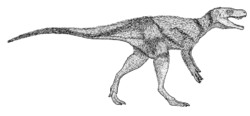| List of years in paleontology |
|---|
| (table) |
Paleontology or palaeontology is the study of prehistoric life forms on Earth through the examination of plant and animal fossils . [1] This includes the study of body fossils, tracks ( ichnites ), burrows , cast-off parts, fossilised feces ( coprolites ), palynomorphs and chemical residues . Because humans have encountered fossils for millennia, paleontology has a long history both before and after becoming formalized as a science . This article records significant discoveries and events related to paleontology that occurred or were published in the year 1995.














